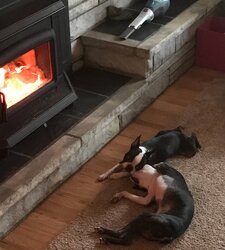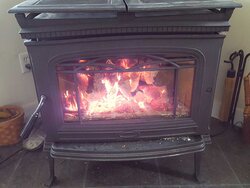gregbesia
Feeling the Heat
How about wood bricks. I know a lot of people burn and like them . http://www.woodpellets.com/blog/wp-content/uploads/2014/05/WOODBRICKS1.jpg
Yes, what you describe above is classic wet wood performance. Too slow to get going, and then stalling after you do. I also fumbled my way thru my first year with this, as there was no way I was going to let anyone convince me to not burn my new stove the first year!Still working on getting those overnight burns, but really struggling to hit much more than 5 hours now. It seems that by the time the stove is hot enough to choke the air down, the wood is already quite a bit burned away. And then once I finally get it down low enough, choking it completely off drops the temp to below the safe zone within an hour. Still struggling to find a balance!
I think the majority of the problem is simply he wood is just too damn wet.

Well certainly the heat is a cycle. It's not like it's going to be 600-700 stovetop temp for 10hrs. I usually build a buffer of heat in the house during the day for overnight. It seems like you're thinking it'll run kind of like a cat stove, just lower output and steady for longer. But it won't. The heat will peak and valley throughout the 'burn time'. I think most describe burn time as the time between loadings. And it's highly subjective, yes you can get a longer burn time if you let the stove cool down more and shorter if you're reloading hot.
I'd say just keep doing what you're doing and if you are finding it chilly overnight. Try to burn a little harder during the day to heat the house up more.
Air flow (which is into the firebox above the front door glass, on most stoves) will play games with the wood, when debating N/S vs. E/W. But for the most part, those looking at fireshow love E/W, and those using the stove as a heater relish N/S loading. When loading N/S, if your stove permits it, you can usually load the box fuller without concern for logs rolling against the glass (or out of the stove before you close the door).Any importance to E/W loading, or mixing the kiln & seasoned dried wood?
Only if you like wasting space. The way most folks split, you're going to be able to pack it in tighter if you pick a direction, and stick with it.Try loading N/S on the bottom then E/W on top of that...
I'm claiming a 10-hr. burn time from my little 1.5 cu.ft. stove....on an average winter day here, and not too windy, I can get enough heat to hold at 70 or so when the stove top is 250+. I have to open up the air on the coals at the end of the burn to keep the stove above 250. 1000 sq.ft, insulation and air-sealing are marginal. If it were better, I wouldn't even need 250 to hold room temp. I realize that it's colder where you are but if a 3 cu.ft stove doesn't keep 1200 sq.ft. warm for more than 5 hrs, with a stove temp of 350, either your house is losing a ton of heat, or your definition of a "warm house" is a much higher temp than mine.I did still have a nice coal bed 10 hours later, but the temperature was no longer above 350F, which is the lowest I like to let it get. When we're talking about "burn times" I would assume we mean the time the oven is running at a "house warming" temperature, right?....I'm actually running only on oak, hickory, maple and ash, so I'm surprised that my unit stops producing the needed heat after 4-5 hours. Maybe I'm misunderstanding what "10 hour burn time" actually represents.......1200 sq ft
 The fact that you are referring to your heater as an "oven" implies that you expect to be baked...
The fact that you are referring to your heater as an "oven" implies that you expect to be baked... 

The larger splits should flatten out the peak-and-valley effect, extending higher heat output later into the load.Larger splits have less exposed surface area, they will burn slower. Load with large splits and use smaller splits as gap fillers if possible.
Total exposed surface area is the dominant factor in combustion rate and temperature. An equal volume of smaller splits has more surface area, and therefore will burn hotter and faster, supplied with adequate air. On stoves where it is not possible to shut down the air as far (eg. non-cat stoves), it can be tougher to limit the amount of air and maintain a controlled burn, if you stuff the stove full with toothpicks.What about wood size? If the volume of total wood is the same, does it matter how many total splits there are? Is it better to will larger splits burn longer, or is total volume the only thing that matters?
I'm claiming a 10-hr. burn time from my little 1.5 cu.ft. stove....on an average winter day here, and not too windy, I can get enough heat to hold at 70 or so when the stove top is 250+. I have to open up the air on the coals at the end of the burn to keep the stove above 250. 1000 sq.ft, insulation and air-sealing are marginal. If it were better, I wouldn't even need 250 to hold room temp. I realize that it's colder where you are but if a 3 cu.ft stove doesn't keep 1200 sq.ft. warm for more than 5 hrs, with a stove temp of 350, either your house is losing a ton of heat, or your definition of a "warm house" is a much higher temp than mine.The fact that you are referring to your heater as an "oven" implies that you expect to be baked...

The larger splits should flatten out the peak-and-valley effect, extending higher heat output later into the load.
 Hoping it can hold steady there for a couple hours as the bed of coal volume is quite impressive.
Hoping it can hold steady there for a couple hours as the bed of coal volume is quite impressive.
Settling in around 225-250 seems cool to me. This is measured on the front of the insert correct? Do you have secondary combustion running at that temp? If you can't tell from the flames can you look outside and see if you have smoke exiting the chimney?


